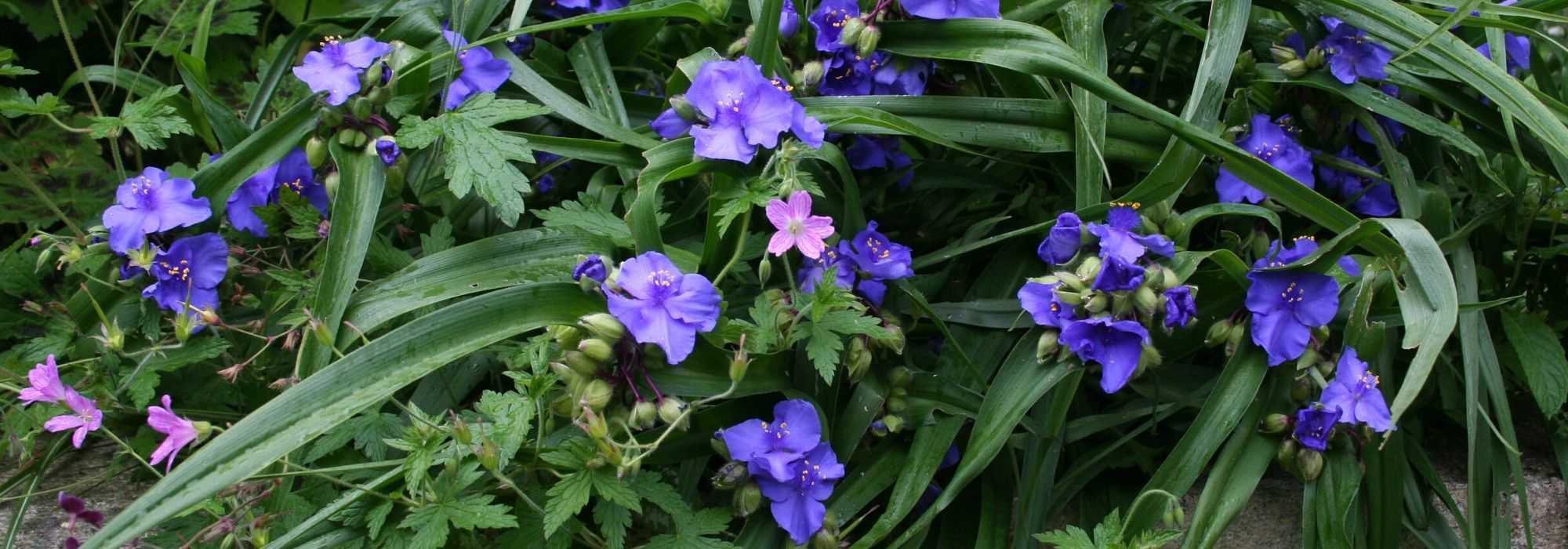
Virginia spiderwort, Tradescantia virginiana: planting, growing, care
Contents
Virginia Bluebell, in a nutshell
- Tradescantia virginiana or spiderwort is a hardy, deciduous perennial that is very easy to grow in our gardens.
- It forms a clump of slender leaves, adorned with large, three-petalled flowers that are blue, pink, or white, unique in their simplicity.
- June is when the plant is at its best, and even though the ephemeral flower lasts only a day, the flowering continues for months.
- The keys to success are soil that does not dry out in summer and full sun or partial shade.
- Virginia’s Ephemeral can be grown in pots to enhance a terrace or balcony.
A word from our expert
Tradescantia form a large family of perennial plants belonging to the Commelinaceae family and originating from both American continents. Some have very decorative, persistent foliage that is purple, wooly, striped, or variegated, and are widely used as houseplants, or even as outdoor groundcover when the climate permits, commonly referred to as “Misery”. There are nearly seventy species of Tradescantia, all perennials sharing flowers with three petals, which are more or less attractive. The most common in our gardens, Tradescantia x andersoniana (or virginiana) is a hardy, floriferous, and reliable perennial that is very easy to grow, known as the “Virginia Spiderwort”, reaching 50 cm in all directions. Its name comes from the fact that each flower in the cluster lasts only one day, but the plant provides both lush foliage and a continuous flowering from June to September, delicate due to the velvety texture of its petals, which should not be missed in fresh and semi-shaded perennial beds. The inflorescence displays bold hues dotted with golden stamens: violet in Zwanenburg Blue, dark blue contrasting with the yellow foliage in Sweet Kate, pink in Red Grape, or pastel tones, white suffused with pale blue in Bilberry Ice, white in Blushing Bride with variegated pink foliage turning to white, lilac pink in Perrine’s Pink …
Invite them without delay into your ordinary, fresh to moist soil beds, exposed to sun or partial shade, in pots or hanging baskets.
Description and botany
Botanical data
- Latin name Tradescantia
- Family Commelinaceae
- Common name Spiderwort, Lady's tears, Spider lily
- Flowering from June to October
- Height between 0.30 and 0.50 m
- Exposure sun or partial shade
- Soil type any humus-bearing soil, fresh to moist, even slightly calcareous
- Hardiness Good (-10 to -20 °C)
The genus Tradescantia includes over 70 species, all native to the North or South American continent. Most of these herbaceous perennials are not hardy and are used in hanging baskets or pots for the beauty of their often striped, glossy foliage, their rapid growth, and their ease of cultivation. The Tradescantia grown in our gardens mainly belong to the Andersoniana group, resulting from the cross-breeding of the virginiana species from the eastern United States (the area between the Connecticut-Wisconsin line to the north, and Georgia-Tennessee and Missouri to the south) with one of the 10 other species (Tradescantia ohiensis, T. subaspera…) from the eastern part of North America. This results in hardy plants capable of withstanding -20°C, forming fairly loose clumps of green, ramified, slightly angular stems, reaching heights of 30 to 45 cm. The fleshy stems change direction slightly at each node (the leaf insertion zone), giving a somewhat angular appearance. They arise from fleshy roots that can be easily separated to divide the clump. Indoor plants, commonly known as Misery, can also be propagated very well in a glass of water and grow surprisingly well even in a forgotten pot.
The leaves, which are fleshy but not succulent – this is not a succulent plant – are sheathing and without petiole. They are linear in shape, more or less narrow in Tradescantia virginiana, pallida, spathacea, x andersoniana, sometimes heart-shaped and imbricate in T. cerinthoides, sillamontana. Their position is alternate and the lamina, folded longitudinally, is usually glossy, sometimes covered with a fine, very dense and silky down, as seen in the species Tradescantia sillamontana (Velvety Spiderwort). In Virginia Spiderwort, the colour varies from dark green to golden yellow, with transverse streaks, pink to white, enhancing the brilliance of the flowering. The foliage and stems disappear with the cold only to re-emerge in mid-spring. In Misery plants, the foliage sometimes takes on shades of purple, velvety grey, or multicoloured stripes.
The flowering of Virginia Spiderwort lasts for several months, starting in May or June and extending until October or even until frost, depending on the climate. However, as its common name suggests, each flower lasts only one day. Within short clusters or umbels, located at the top of the stems, the flowers, about 3 cm wide, are borne on a peduncle that straightens at the moment of blooming, while the faded flower turns back towards the ground. The flower has 6 stamens with often golden-yellow anthers that sparkle at the centre of the corolla and 3 fused carpels. Young fruits can be cut to prevent exhausting the plant, provided they are not confused with the buds! The simplest method is to cut back the clump when the foliage begins to droop, in order to regenerate a vigorous clump that will flower again in autumn. Sowing is quite common, and the plant can exhibit an invasive character in cool situations.

Several colours of Tradescantia andersoniana
Some species of Tradescantia (T. albiflora, T. spathacea, and T. pallida) may cause contact allergies (redness and itching) in dogs and cats.
“`
The main varieties of Tradescantia
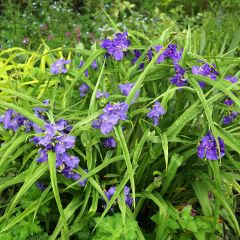
Tradescantia andersoniana Zwanenburg Blue - Spiderwort
- Flowering time July to September
- Height at maturity 50 cm
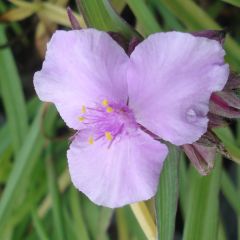
Tradescantia andersoniana Perrines Pink - Spiderwort
- Flowering time July to September
- Height at maturity 40 cm
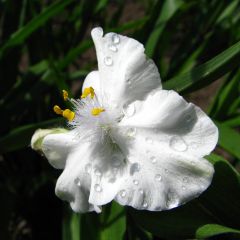
Tradescantia andersoniana Innocence - Spiderwort
- Flowering time July to September
- Height at maturity 50 cm
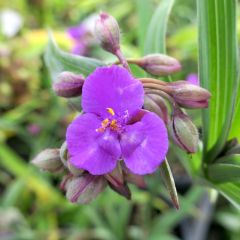
Tradescantia x andersoniana Concord Grape
- Flowering time July to October
- Height at maturity 50 cm
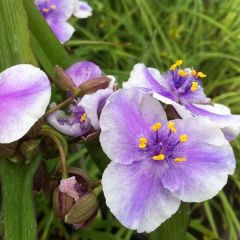
Tradescantia andersoniana Bilberry Ice - Spiderwort
- Flowering time July to September
- Height at maturity 45 cm
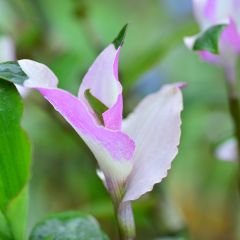
Tradescantia andersoniana Blushing Bride - Spiderwort
- Flowering time June to November
- Height at maturity 50 cm
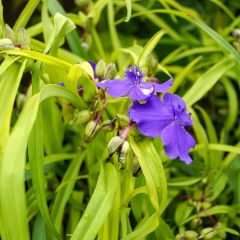
Tradescantia Sweet Kate - Spiderwort
- Flowering time July to September
- Height at maturity 40 cm
Discover other Tradescantia - Spiderwort
View all →Available in 1 sizes
Available in 1 sizes
Available in 0 sizes
Available in 0 sizes
Available in 2 sizes
Available in 1 sizes
Available in 2 sizes
Available in 1 sizes
Available in 1 sizes
Available in 3 sizes
Planting
Where to plant Tradescantia?
Spiderwort prefers humus-bearing or clay soils, cool to moist, slightly acidic to alkaline. The plant flowers more in the sun if it receives regular watering. Otherwise, place it in a partially shaded spot where it will better withstand short periods of drought.
However, it dislikes root competition from other perennial suckers or stoloniferous plants.
When to plant?
Prefer autumn (October-November) or spring to install your Virginia spiderworts while the stems are still underdeveloped.
How to plant in the garden?
This plant is very easy to grow. Here’s how to plant it in the garden:
- Remove the root ball from its pot and untangle the roots if necessary.
- Loosen the soil to a width of 40 cm and a depth of 20 cm, then place the root ball at the same level as the plant in its pot.
- If the soil is poor, add compost.
- Firm the soil around the root ball with your hand. The root ball should remain in the ground when you pull on the stems.
- Water generously.
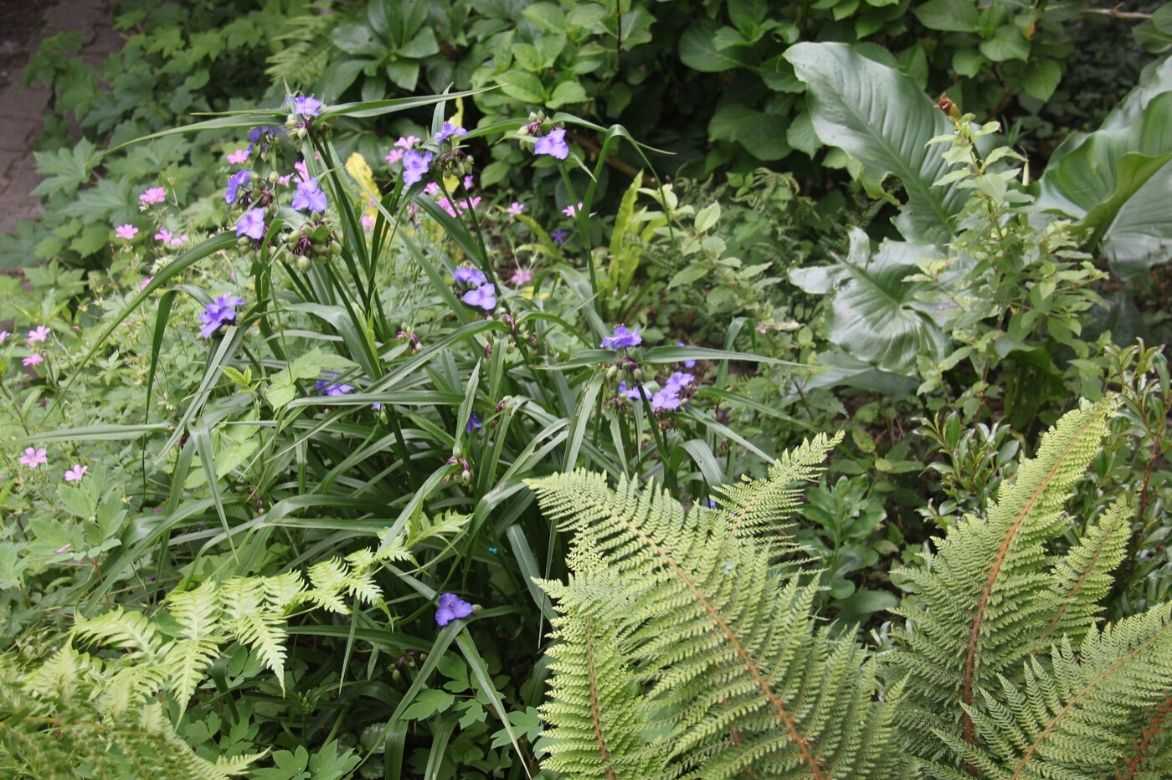 Tradescantia in a shaded area
Tradescantia in a shaded area
How to plant in a pot?
- Take a pot of about 30 cm and place a drainage layer at the bottom (clay balls, gravel, pumice…) about 5 cm deep,
- You can add a piece of geotextile felt to prevent the drainage material from mixing with the substrate,
- Make a mix of potting soil (1/3) and garden soil (2/3) or use only good quality horticultural potting soil,
- Fill the pot halfway, place the plant, and fill the gaps with your mix,
- Water well at planting and keep the substrate slightly moist throughout the growing season.
→ Learn more in our article: Growing Virginia Tradescantia in a pot
Read also
How to pair Virginia Tradescantia?Care
- Ensure to maintain slightly moist soil to encourage flowering.
- To ensure continuous flowering until the frost period, care should be taken to cut off faded flowers.
- You can cut back the foliage to the ground in November, knowing that the first frost destroys the foliage.
- In spring, watch for slugs and caterpillars to limit potential damage.
- A clump of Tradescantia andersoniana has a lifespan of about 10 years without gardener intervention (division) and in good growing conditions.
Propagation
Multiplication is done by dividing the clumps:
Before the shoots grow too much, slice the clump with a sharp spade and extract a portion of the clump.
Replant immediately in another location cleared of other plant roots.
Learn more in our tutorial: Multiply tradescantia or spiderwort: our 2 easy methods.
Uses and pairing ideas
Spiderworts can be used to fill spaces in a perennial bed that prefers cool soil, such as astilbes, astrances, monardas, Carex, tiarellas, Japanese primroses, or autumn-flowering saxifrages fortunei. You can also pair them with hardy geraniums, Knautias, or Phlox.
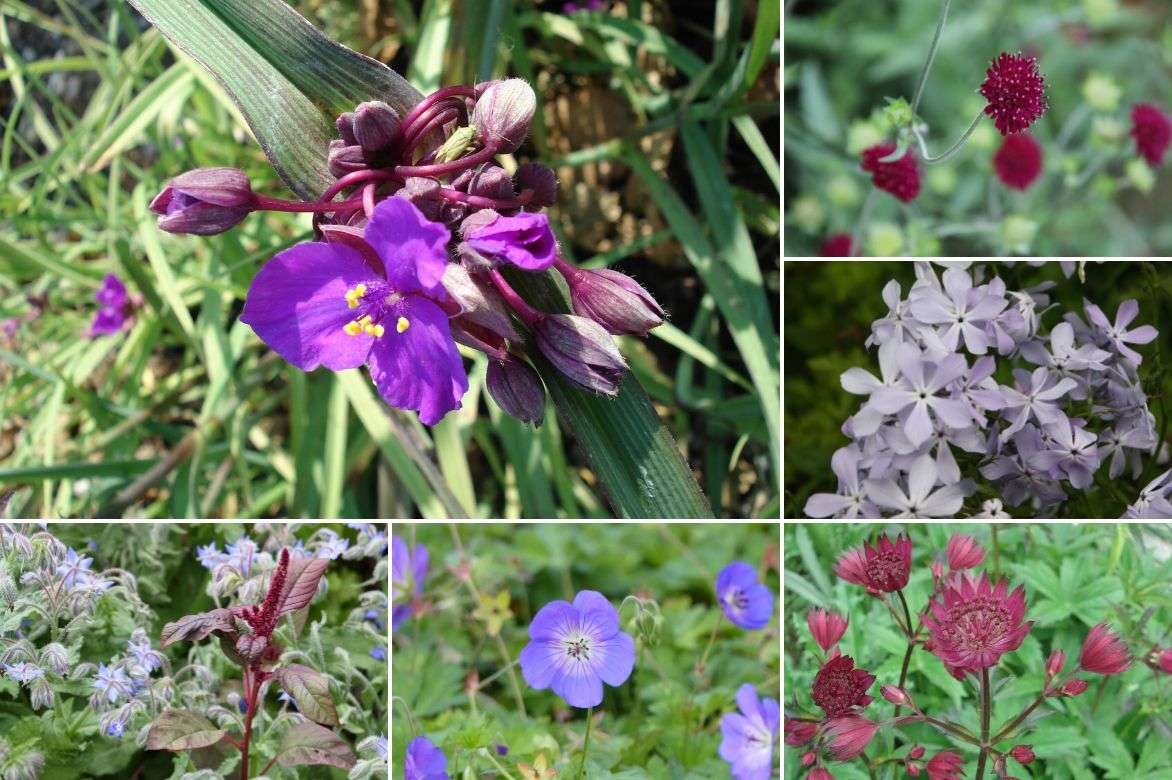
An example of a natural association, in sun and cool soil: Tradescantia andersoniana ‘Red Grape’, Knautia macedonia, Phlox divaricata ‘Clouds of Perfume’, Astrantia ‘Ruby Wedding’, Hardy geranium ‘Azure Rush’, Atriplex hortensia rubra, and Borago officinalis
They will also enliven small shady areas such as cool rockeries, the base of a shaded wall, or a woodland where they can naturalise, as well as the banks of streams or ponds alongside arums or hostas. Very adaptable, Tradescantia can also fill the base of roses.
→ Discover more ideas for pairing Tradescantia.
Did you know?
The generic name Tradescantia honours John Tradescant the Younger (1608-1662), an English botanist who set out to explore Virginia in North America, from which he brought back Magnolia, Aster, Phlox, false cypress, and Tulip tree (Liriodendron tulipifera). He was the gardener to Charles I.
For further reading
Discover our range of Virginia Spiderworts.
Explore our ideas for pairing Tradescantia.
Our article: Growing a Virginia Tradescantia in a pot.
Our articles: Tradescantia, the most beautiful varieties; 5 Tradescantia with blue or mauve flowers.
- Subscribe!
- Contents
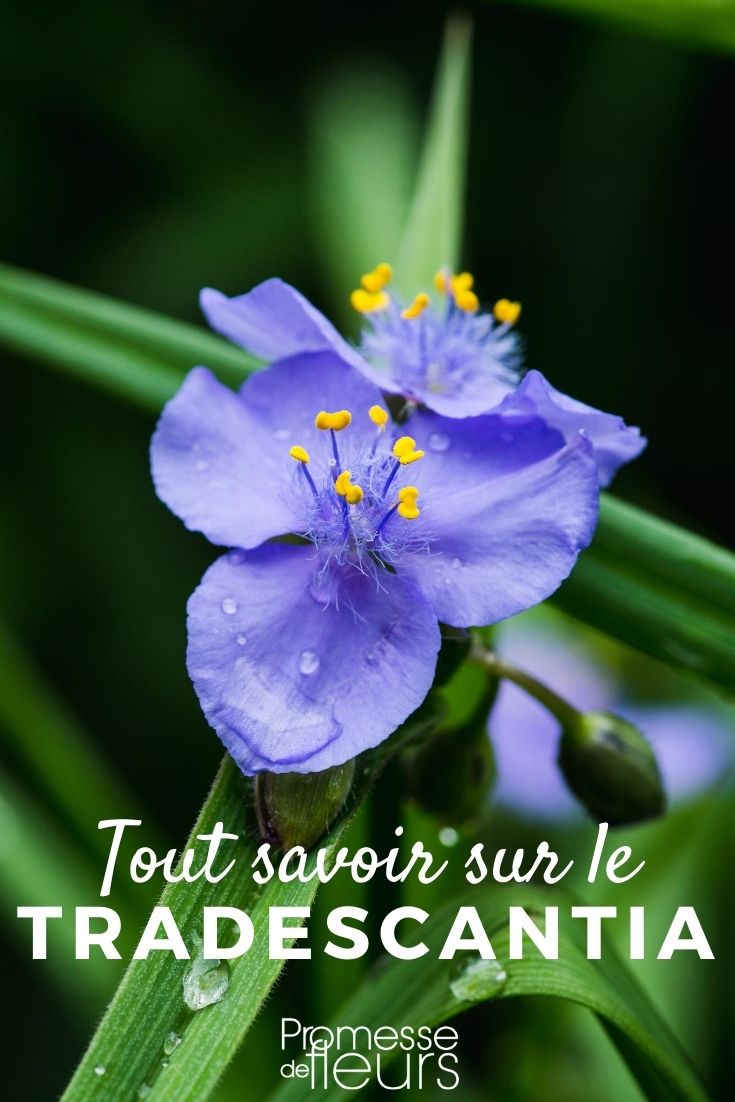
































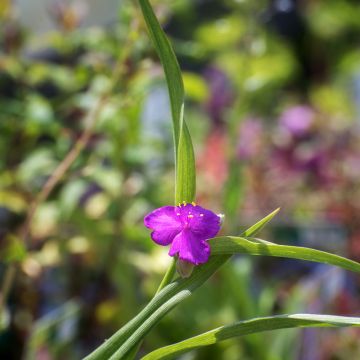
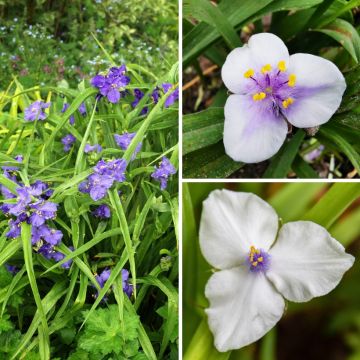
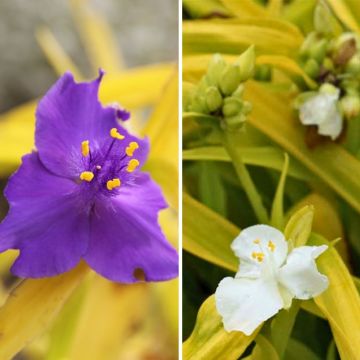
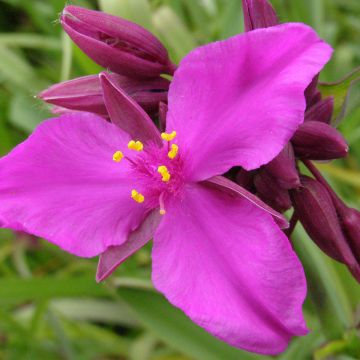
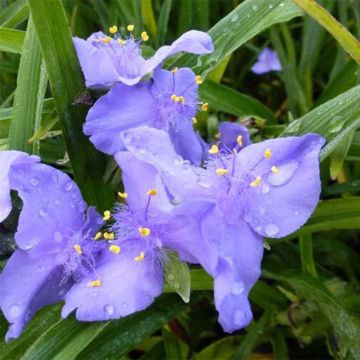
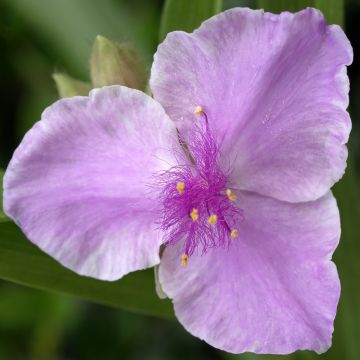

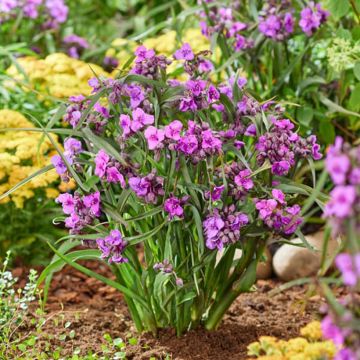
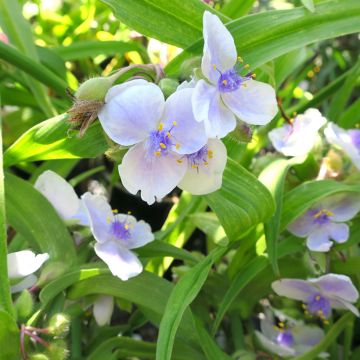
Comments